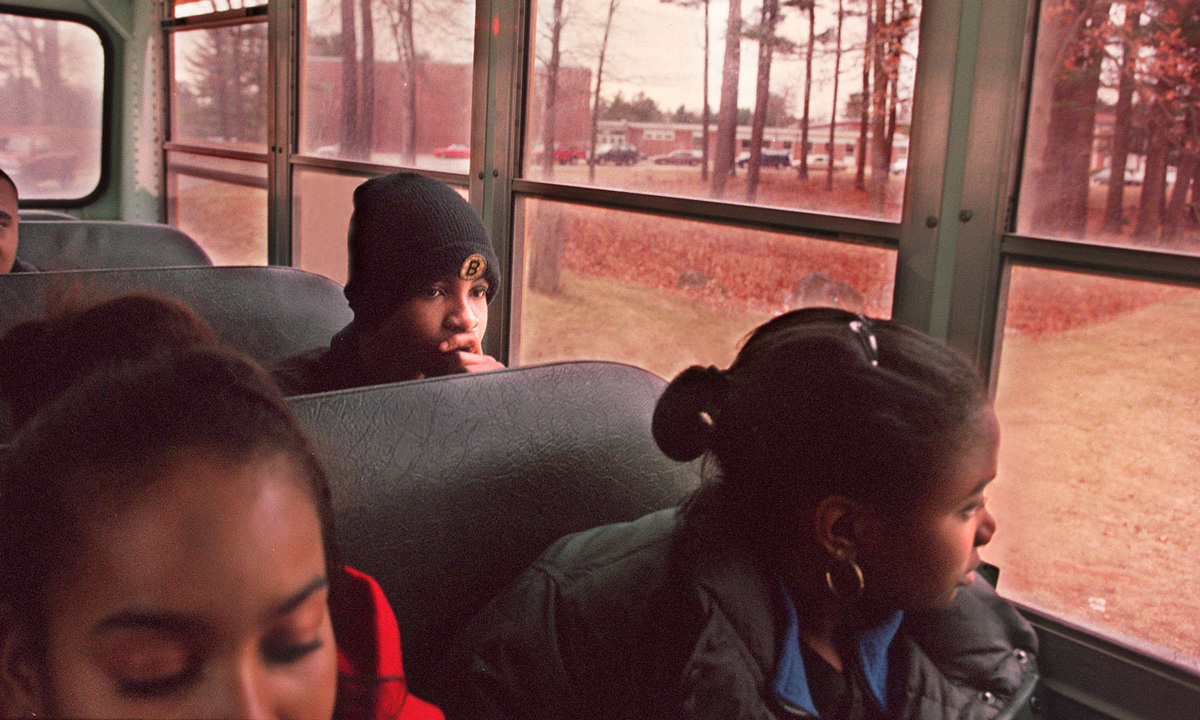Boston’s Better Busing Experiment: METCO Makes Huge Educational Impact
Since 1966, METCO has brought students from Boston to schools in nearby suburbs. A recent study finds that it boosts their learning — and earnings.

Get stories like this delivered straight to your inbox. Sign up for The 74 Newsletter
To many outsiders, Boston Public Schools’ court-ordered integration campaign of the 1970s and ‘80s was an unqualified failure that stoked more racial discord than it solved, turning “busing” into a byword for disaster for years to come.
But as commentators commemorate the 50th anniversary of that controversy this year, few have remarked on the legacy of a much more durable, and more successful, effort to bus underserved kids to better educational opportunities: METCO, an initiative that offers Boston students slots in several dozen suburban communities that participate voluntarily. With considerably less fanfare, the program has made a serious dent in segregation across one of the country’s biggest metropolitan areas.
Until recently, researchers struggled to quantify METCO’s effects. But a paper released in August has provided the fullest overview yet of how students’ lives change after being bused to better-performing school districts.
The study, conducted by Tufts University economist Elizabeth Setren, finds that over the last few decades, METCO students enjoyed sizable improvements to their standardized test scores, school attendance, and disciplinary records compared with similar peers who didn’t participate. They were also more likely to both start and graduate from college and later earned substantially higher wages. The effects were especially large for boys and children whose parents didn’t attend college.
Those successes, achieved by a program with little national recognition, could offer lessons to states and districts attempting to engineer more racial and socioeconomic balance in their classrooms. Both legal hurdles and changing demographics have made desegregation a more complex process than it was during the movement’s heyday, but many education leaders are concerned about national data indicating that racial isolation has ticked upward since the 1990s.
It was in an effort to achieve racial balance across Boston’s heavily segregated neighborhood schools that a federal judge ordered local officials to shuttle students to schools in different parts of the city. Researchers are unsure what academic improvements resulted from racially directed school assignment, but the political response was so resoundingly hostile that the project was wound down by the end of the 1990s. By contrast, METCO has grown significantly since its inception and is now one of the longest-running voluntary desegregation programs in the country.
That speaks to the importance of this shift in expectations. Now these kids are learning more and expected to go to college more.
Elizabeth Setren, Tufts University
Setren said that her research, which relied on huge troves of student assignment, college enrollment, and later-life employment data, was especially compelling given the “unusual” granularity of information she was able to use to identify METCO’s impact.
“What the METCO setting tells us is that going to schools in neighborhoods with much higher college aspirations, much higher college-going rates, and more advanced curricula can lead to a transformative change for these students’ academic and career trajectories,” she said.
To pinpoint the direct consequences of taking part in METCO, Setren only studied children whose parents filled out applications, whether successfully or unsuccessfully. Because the program receives many more applications than its roughly 3,300 annual slots, the study could simply compare the outcomes of those who were accepted — at the time, on a first-come, first-served basis, though a lottery has been used more recently — versus otherwise-similar students who were not.
In all, Setren found, METCO students scored considerably higher on state tests, drawing 49 percent closer to the Massachusetts average in English than their peers by the third grade. They were only two-thirds as likely as their BPS peers to be suspended, and they accrued between three and nine fewer absences each year, in spite of the transportation hassle and time crunch of getting to school miles away from their own neighborhoods.
Things only got better from there: Making the trip to a suburban school raised children’s rate of graduating from high school on time from 79 to 92 percent, while lowering their chance of dropout from 4 to just 1 percent. Participants’ chances of scoring at least 1000 on the SAT were nearly nine points higher, while their chances of scoring 1200 or above were two points higher. They were 21 percentage points more likely to enroll in college and 12 points more likely to graduate.
Perhaps most striking of all is the impact farthest removed from the K–12 years. For those who work in Massachusetts, METCO students earn, on average, $7,708 more annually by the age of 25 than those who never received an offer. Ten years later, that gap grows to an average of $16,250.
Positive peer effects
If the benefits of busing between districts are clear, how they are achieved is somewhat less so.
The act of switching school districts amounts to “a bundle of changes about your academic career” all occurring simultaneously, Setren observed, making it difficult to isolate which factors led to academic and behavioral improvements. But some evidence supports the idea that exposure to higher-performing peers and loftier expectations could be exerting the most influence.
In 1966, when METCO was launched, the differences in resources between Boston and its inner-ring suburbs were greater than they are today. But in 2021, Boston Public Schools spent more than $31,000 per pupil, one of the highest rates in the nation. That figure is also higher than the vast majority of the 38 districts that accept METCO transfers, making it unlikely that higher funding is powering participants to more learning.
Setren also found that the various inclusion measures taken by districts to welcome students coming from Boston — including tutoring, after-school transportation, and access to social workers — made little difference to whether they flourished in their new schools; regardless of whether their new districts took such steps, METCO participants massively out-performed their peers in Boston Public Schools.
Some important differences separate the schools in receiving districts, however. They pay their teachers, on average, $3,000 more per year, which could be explained by the fact that they can boast roughly one year more classroom experience than those working in Boston. METCO participants are less likely to be taught by someone with less than two years’ prior experience — but also less likely to be paired with an African American or Latino teacher, which research has consistently shown can boost their achievement and belief in themselves.
By comparison, however, the classmates they encounter are appreciably different from those they leave behind. METCO participants study alongside pupils who are less than one-third as likely to come from low-income families, who score much higher on state exams, and who are less frequently disciplined by teachers. In their freshman year of high school, METCO students are less than half as likely to have a classmate who was suspended the previous year.
Even more notably, enrolling in the program transforms the expectations they meet every day. While only about half of students in non-METCO classrooms pursue a four-year degree, more than three-quarters of those in METCO classrooms do.
The biggest difference comes from peers. So it's not surprising if that's explaining a large part of the improvement in performance.
Kenneth Ardon, Salem State University
Kenneth Ardon, an economist at Salem State University who co-authored an earlier study on METCO, noted broad commonalities in resources, teacher experience, and curricular materials between Boston and nearby communities. While cautioning that he was not familiar with Setren’s work, he said it made sense that the influence of peers would play a prominent role in lifting students’ life outcomes.
“As you go through and compare urban districts to suburban ones, the biggest difference comes from peers,” Ardon said. “So it’s not surprising if that’s explaining a large part of the improvement in performance.”
Setren agreed, noting that METCO’s largest impact was manifest in children who were previously least exposed to higher education. For both college aspiration and enrollment in four-year degree programs, participants with parents who didn’t graduate from college saw gains more than one-third larger than those with at least one college-educated parent.
“I think that speaks to the importance of this shift in expectations,” Setren argued. “Now these kids are learning more and expected to go to college more than they would have been otherwise.”
Get stories like these delivered straight to your inbox. Sign up for The 74 Newsletter

;)


